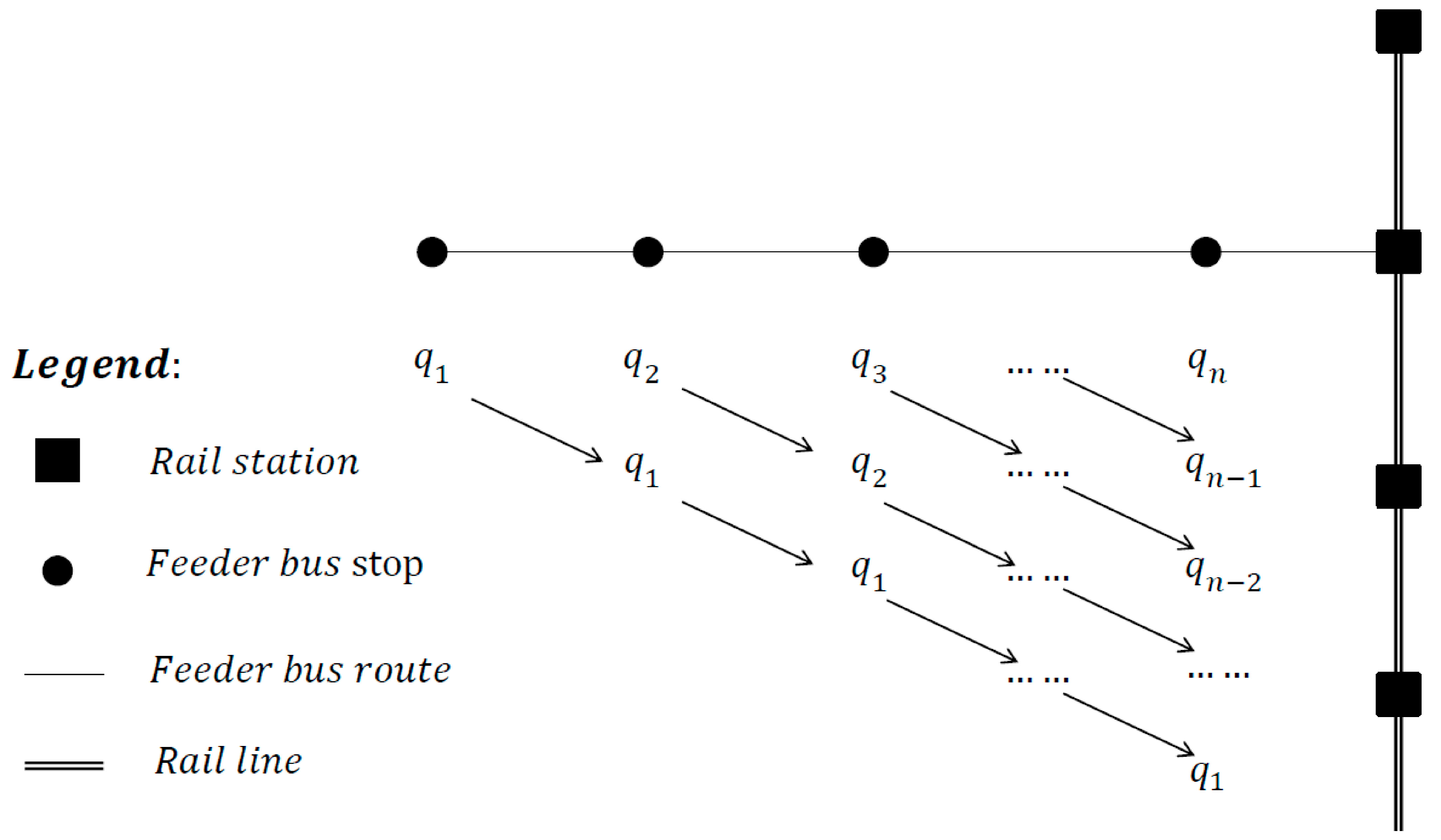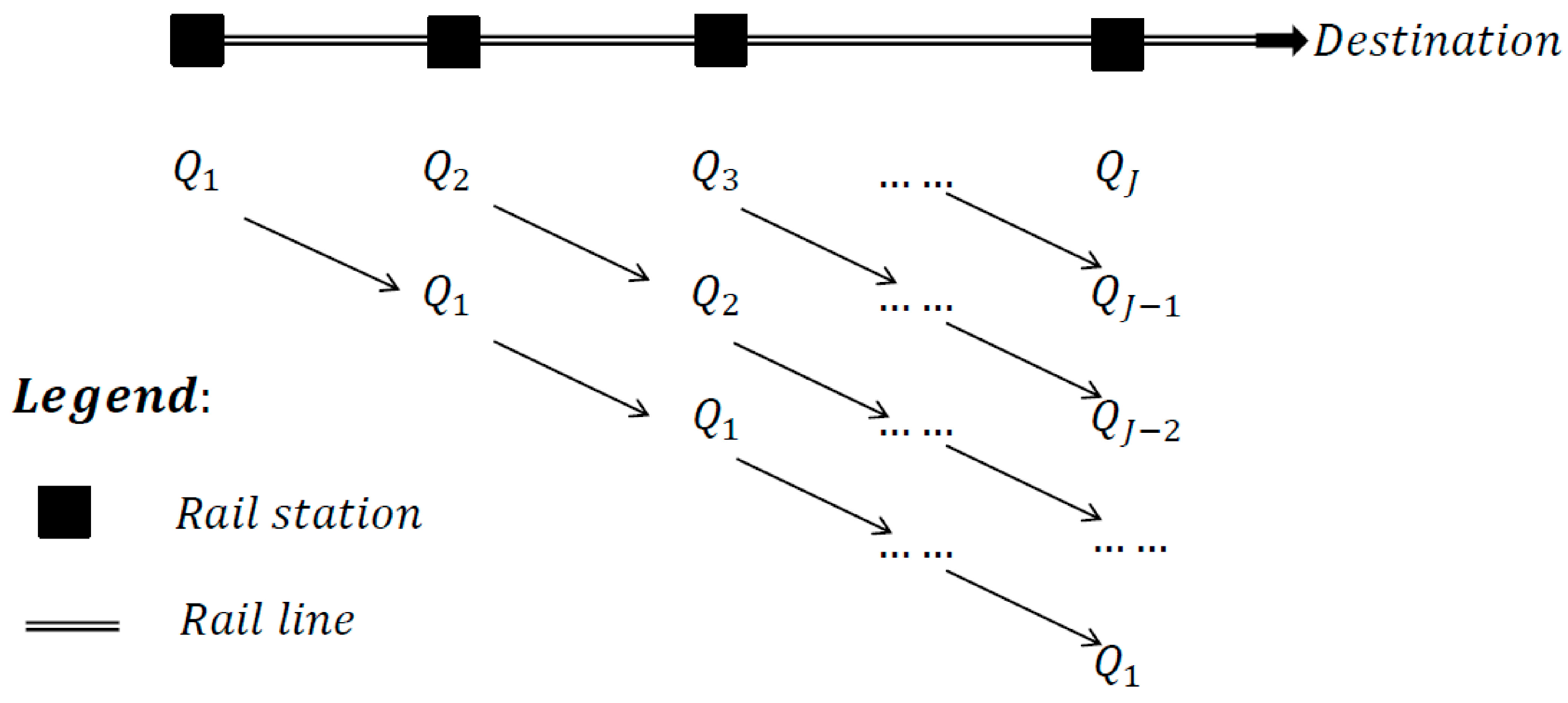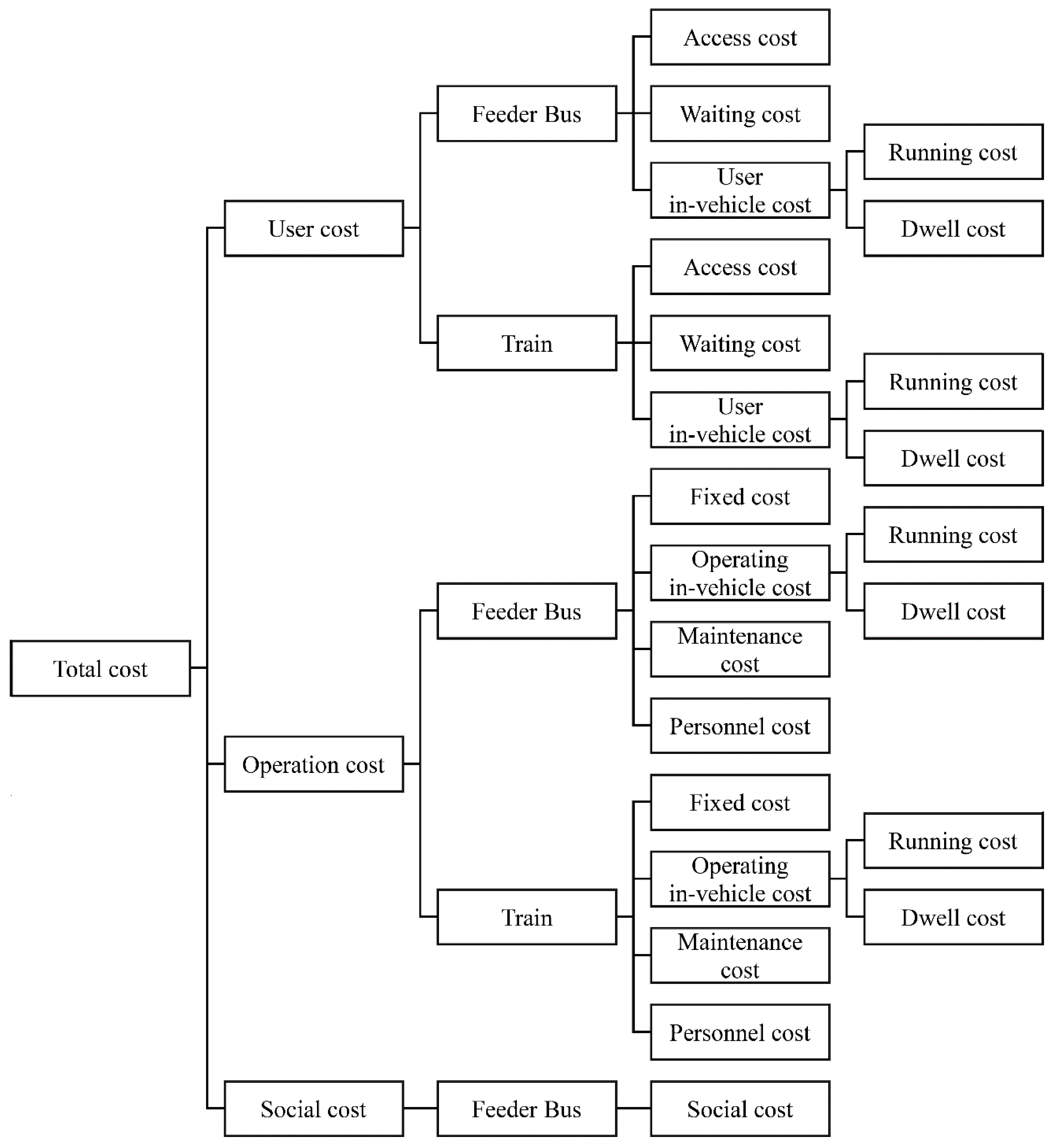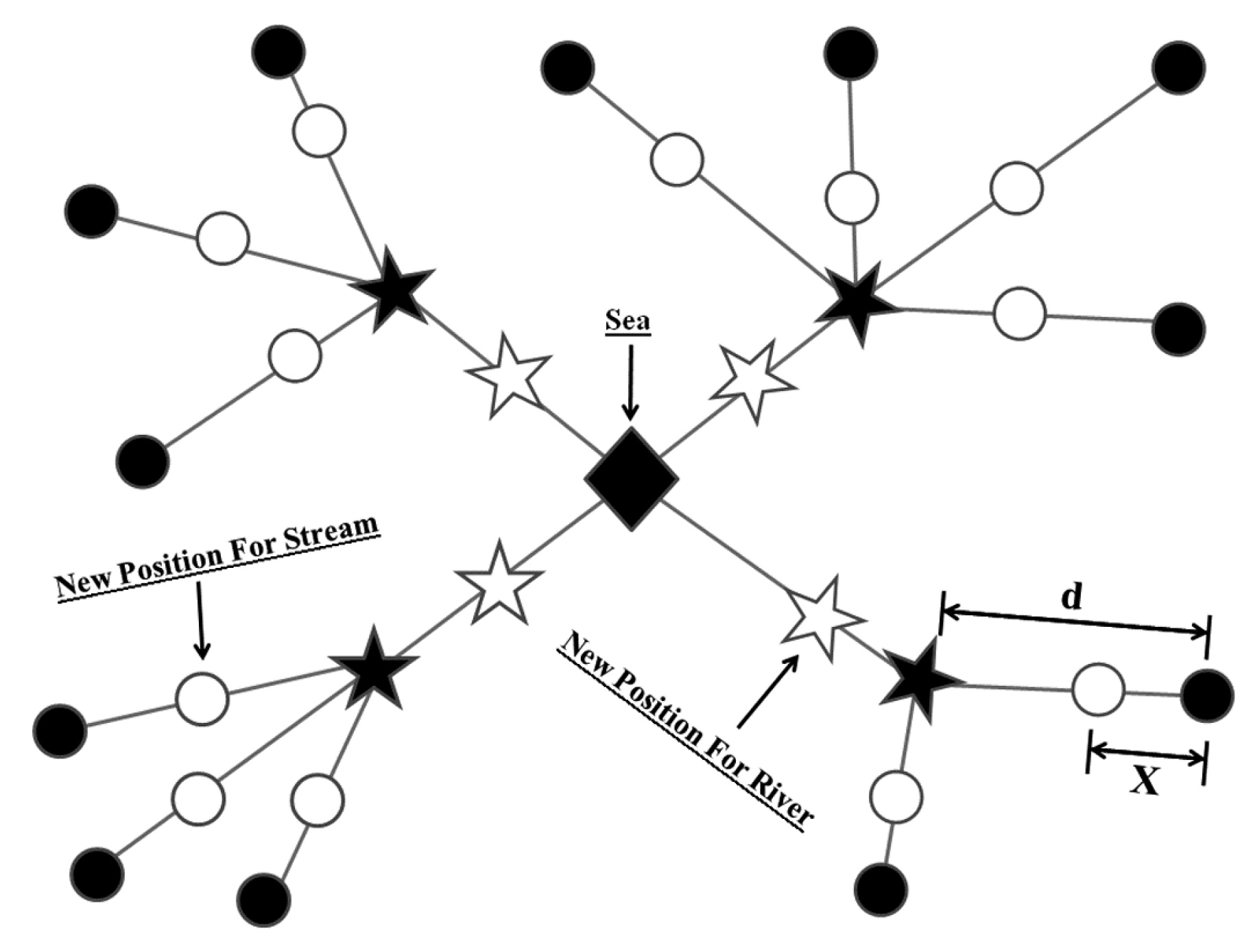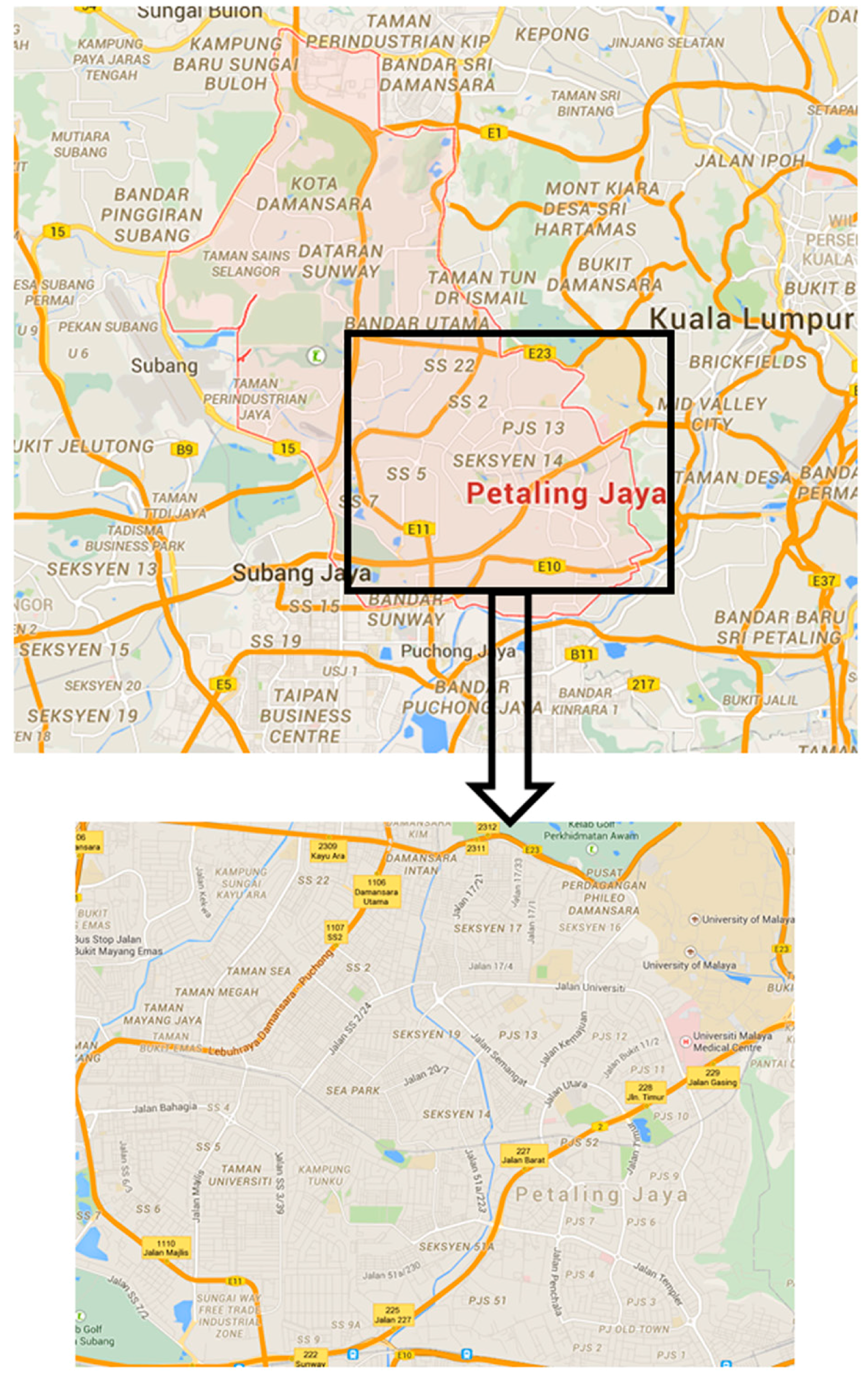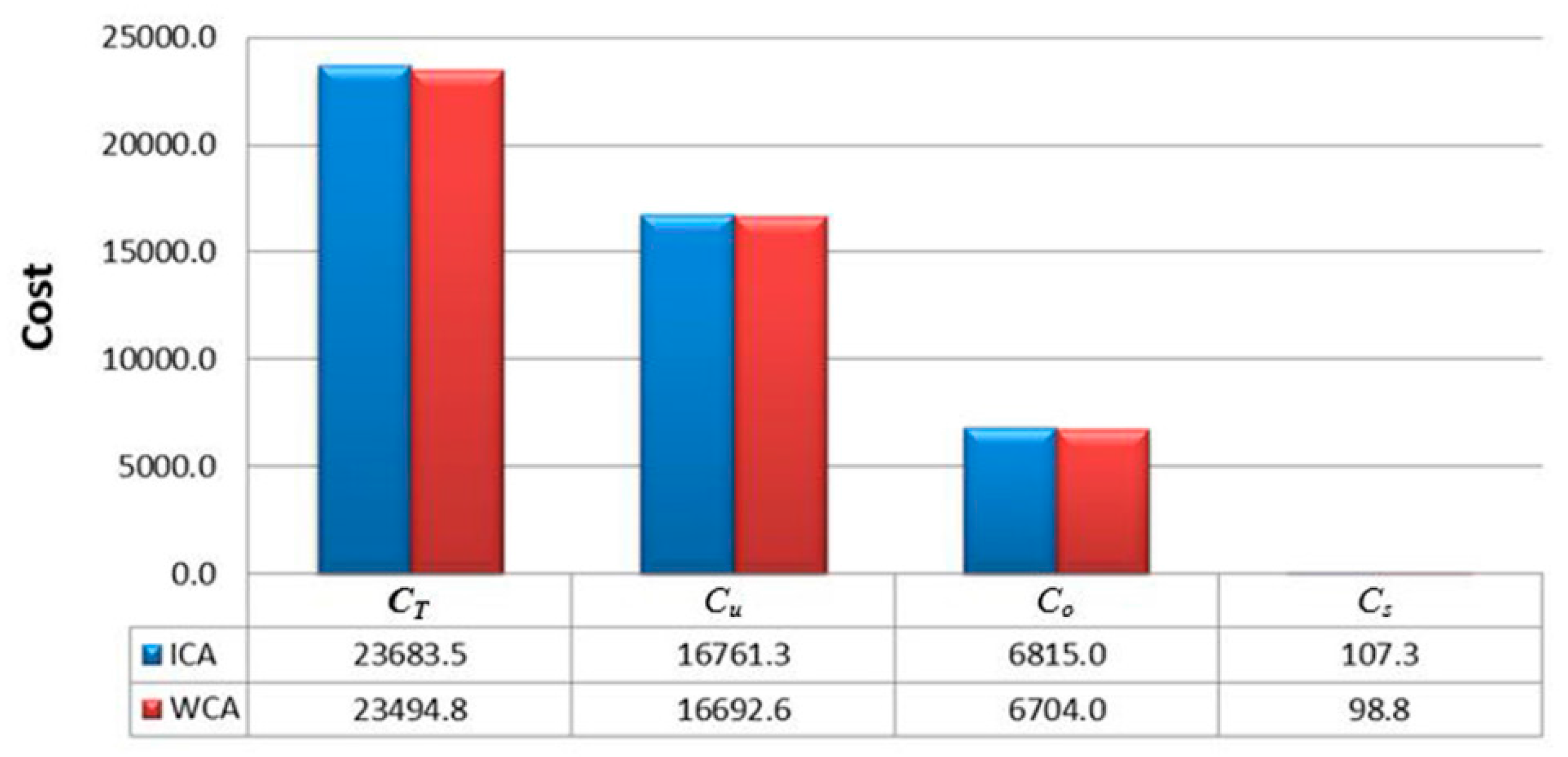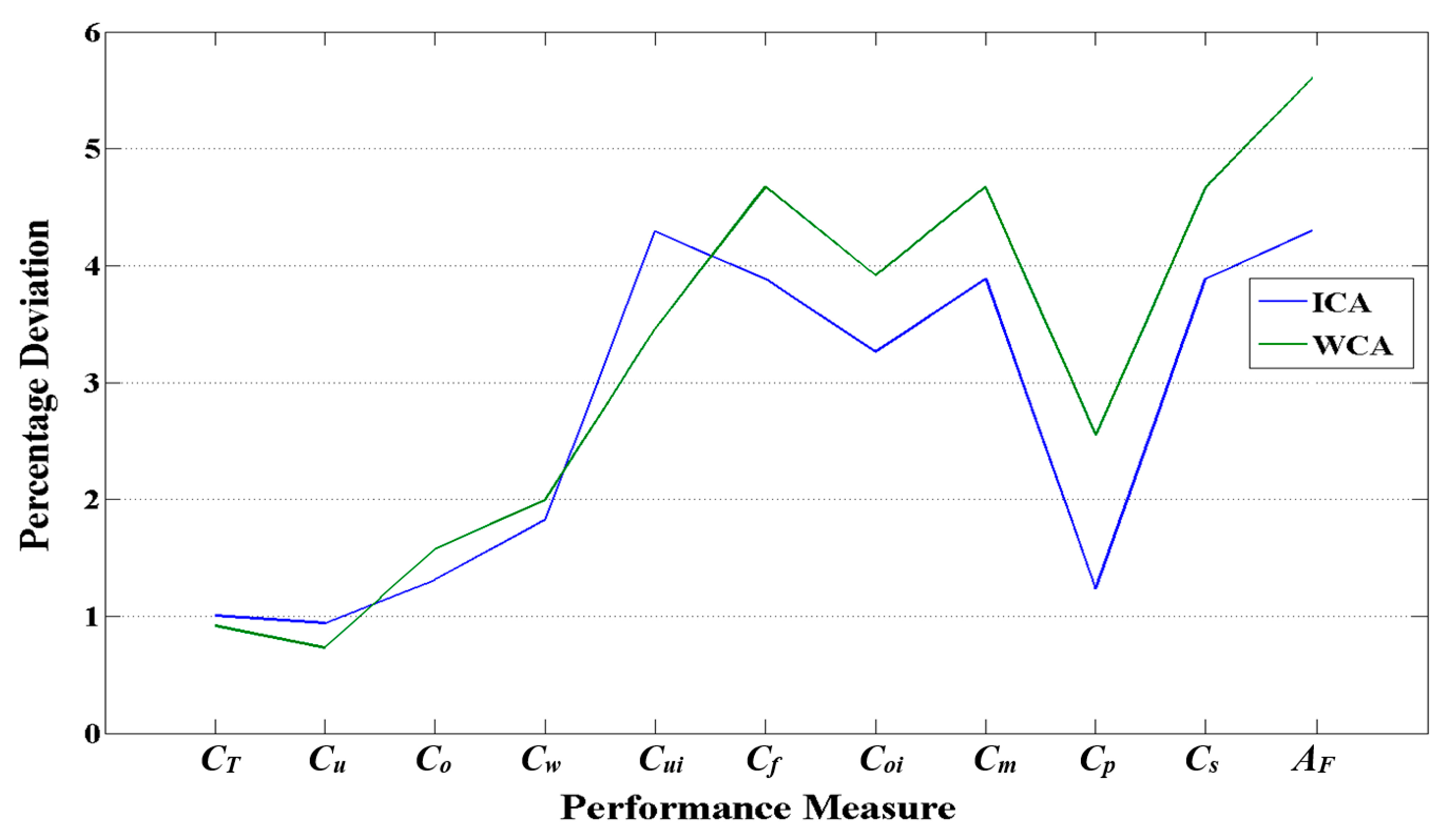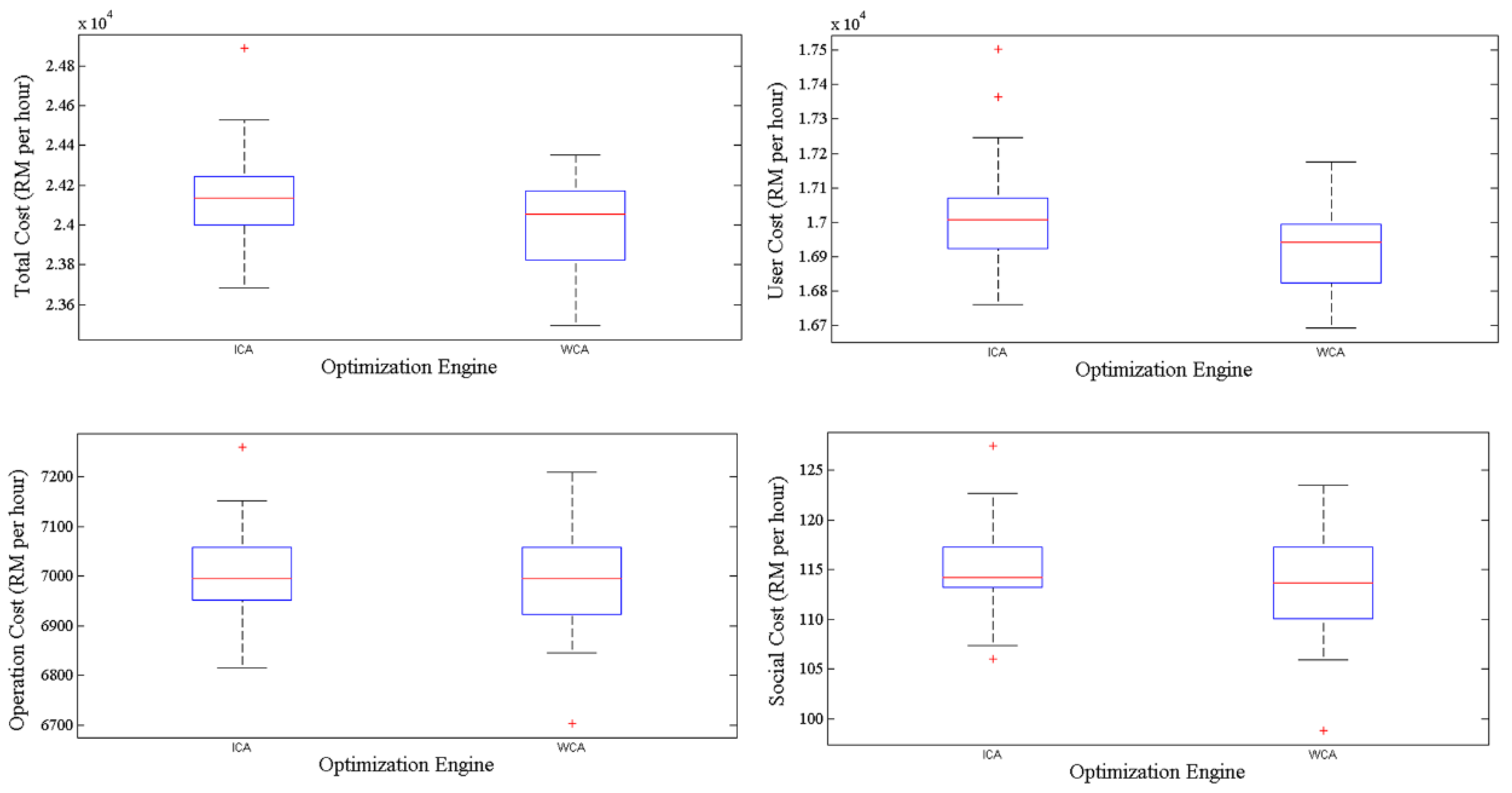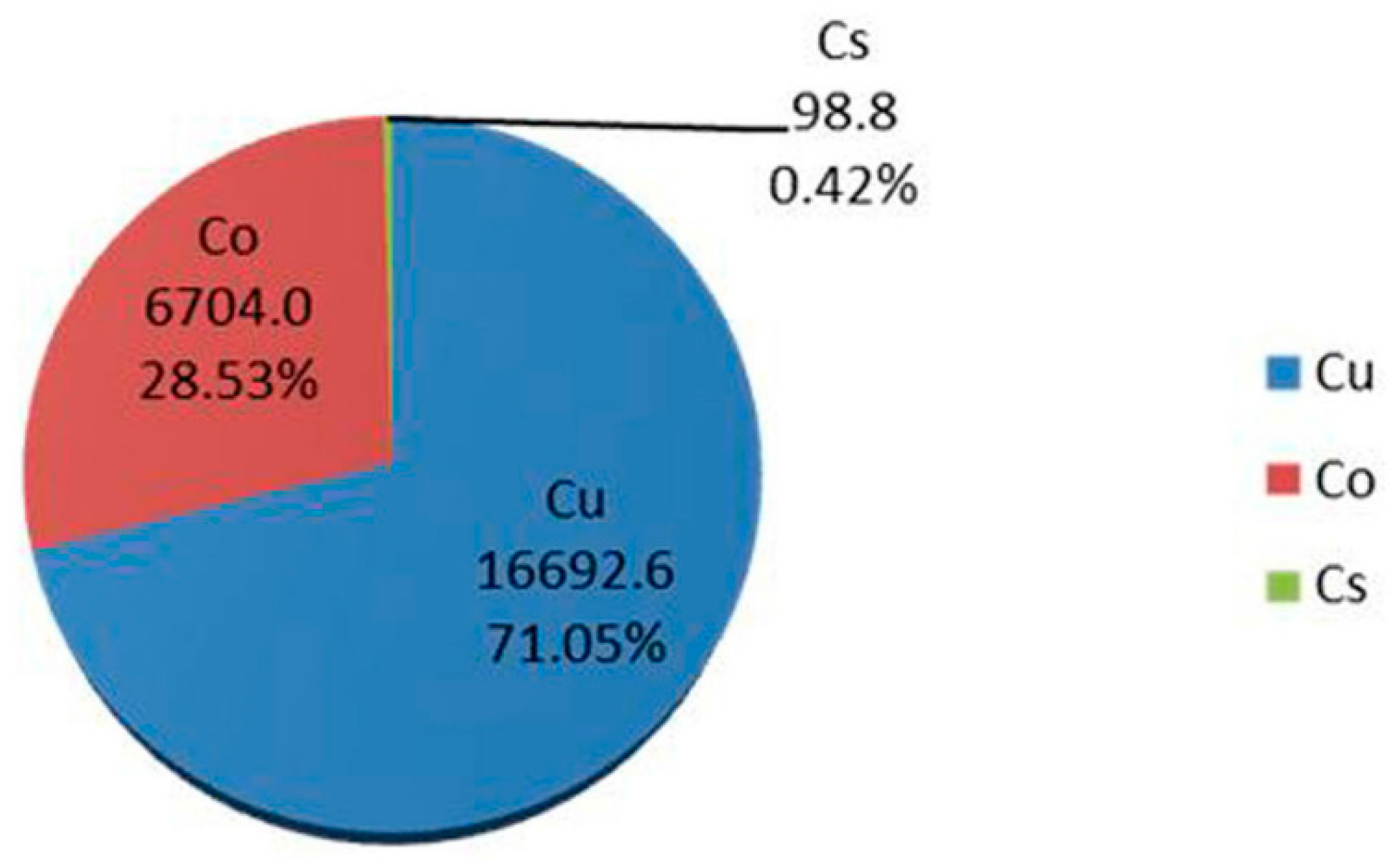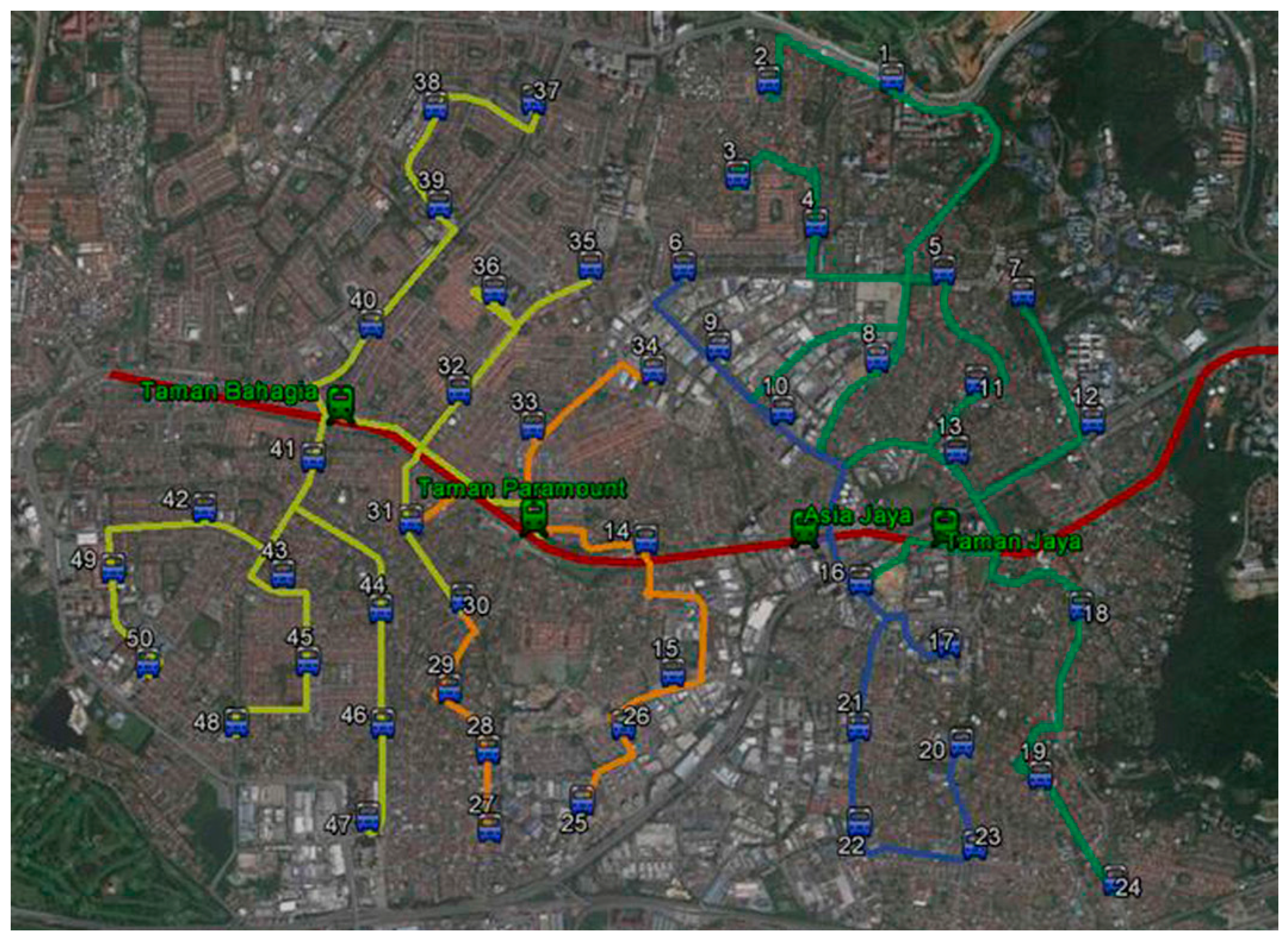1. Introduction
Transportation is a multimodal, multi-problem and multi-spectral system, as it involves different categories and activities, such as policy-making, planning, designing, infrastructure construction and development. Currently, considering the significant developments in technology, economy and society, an efficient transportation system plays a key role in passengers’ satisfaction and the reduction of costs.
Many people use public transportation systems to reach their destination; however, others employ personal vehicles. Passengers are more likely to use a transit service that is highly reliable. Travelers may switch to other transportation modes if a transit service does not provide the expected levels of service [
1]. To prevent the increase of private transport entering city centers, effective alternative travel modes must be provided [
2]. Nuzzolo and Comi [
3] investigated methods of transit network modelling that can be implemented in transit decision-making support system tools to improve their performances, according to the latest innovations in information technology and telematics.
In addition, a good public transportation system has been recognized as a potential means of reducing air pollution, decreasing energy consumption, increasing mobility and improving traffic congestion. In order to improve complicated public transportation systems, a well-integrated transit system in urban areas can play a crucial role in passengers’ satisfaction and reduce operating costs. This system usually consists of integrated rail lines and a number of feeder routes connecting transfer stations.
In general, previous approaches to tackle transit network problems can be divided into two major groups: analytic and network approaches. These approaches differ in their purposes and have different advantages and disadvantages. They should be considered as complementary rather than alternative [
4]. Numerous studies have attempted to implement analytic models [
5,
6,
7,
8,
9,
10]. On the other hand, some of the researchers adopted network approaches instead of analytical methods [
2,
11,
12,
13,
14]. Many studies have been carried out to identify solutions using the aforementioned approaches. These can be categorized into four groups, namely mathematical, heuristic, metaheuristic and hybrid techniques [
15].
Kuah and Perl [
6] presented a mathematical method for designing an optimal feeder bus network to access an existing rail line. Furthermore, Chang and Hsu [
10] developed a mathematical model to analyze the passenger waiting time in an intermodal station in which the intercity transit system was served by feeder buses. They presented the analytic model for quantifying the relationships of passenger waiting time to the reliability of feeder bus services and the capacity of intercity transit.
A large number of research papers has been published in recent years utilizing heuristic methods due to their flexibility. Shrivastav and Dhingra [
12] developed a heuristic algorithm to integrate suburban stations and bus services, along with the optimization of coordinated schedules for feeder bus services using existing schedules for suburban trains. Sumalee
et al. [
16] proposed a stochastic network model for a multimodal transport network that considers auto, bus, underground and walking modes. Chowdhury [
9] proposed a model for better coordination of the intermodal transit system. Furthermore, Steven and Chien [
17] suggested the use of a specific feeder bus service to provide shuttle service between a recreation center and a major public transportation facility. They suggested an integrated methodology (i.e., analytical and numerical techniques) for the development and optimization of decision variables, including bus headway, vehicle size and route choice.
In terms of metaheuristic methods, Kuan [
13] applied genetic algorithms (GAs), ant colony optimization (ACO), simulated annealing (SA) and tabu search (TS) to resolve a feeder network design problem (FNDP) for a similar work conducted by Kuah and Perl [
11], which improved previously-proposed solutions.
In another study carried out by Shrivastava and O’Mahony [
18], optimum feeder routes and schedules for a suburban area were determined using GAs. Mohaymany and Gholami [
19] suggested an approach for solving multi-modal FNDP (MFNDP), whose objective was to minimize the total operator, user and society costs. They used ACO for constructing routes and modifying the optimization procedure in order to identify the best mode and route in the service area.
Hybrid methods are categorized as another type of solution method that combines the abilities of different computational techniques to solve complex problems. Shrivastava and O’Mahony [
20] developed the Shrivastava–O’Mahony hybrid feeder route generation algorithm (SOHFRGA). The idea was to develop public bus routes and to coordinate schedules in a suburban area.
Numerous researchers have attempted to design a more efficient feeder network and to provide feeder services connecting major transportation systems and welfare facilities. The main target of this paper is to represent an improved model and to present an efficient transit system to increase the efficiency of feeder network designs in order to minimize costs.
The structure of this paper is organized as follows:
Section 2 and
Section 3 present a brief description and definition of the problem and explain the details of the mathematical model, respectively.
Section 4 provides succinct representations of the applied ICA and WCA in order to optimize the transit system problem considered. The computational optimization results obtained from the methods used along with a discussion and comparisons are presented in
Section 5. Finally, the concluding results and suggestions for future research are given in
Section 6.
2. Problem Definition and Assumptions
In large metropolitan areas, particularly those with high transit demand, an integrated transit system consisting of rail lines and a number of feeder routes connected at different transfer stations is essential. Consequently, designing a proper feeder network that can provide access to an existing rail system and coordinate the schedule of transit service can be a significant issue.
The development of improved integrated intermodal systems can result in a higher quality of service and passenger satisfaction by providing better coverage, reduced access time, minimal delay and shorter travel times. From the transit operators’ point of view, the operating costs may be reduced by an overall coordination between different public transport modes. Profit can also be increased by shorter route maintenance and eliminating the duplication of routes by trains and buses.
This study is focused on designing a set of feeder bus routes and determining operating frequency on each route, such that the objective function of the sum of the operator, user and social cost is minimized. The mathematical formulation of the improved model and the details of the constraints are presented in the following sections.
An intermodal transit network consisting of a rail line and feeder bus routes connecting the transfer stations is assumed to serve the examined area. The optimal transit system will be determined based on an assumed route structure (
i.e., one rail line and feeder bus routes are linked with straight lines between nodes) and the peak hour demand situations in the entire service area. To formulate the mathematical model for an intermodal transit system and its application in the case study, the following assumptions are made:
- (1)
The transit network was designed with feeder buses and a fixed rail line.
- (2)
Transit demand is assumed to be independent of the quality of transit service (i.e., fixed demand). The demand pattern for feeder bus routes is many-to-one.
- (3)
The location of nodes (i.e., bus stops and rail stations) is given. Some of the model parameters (e.g., vehicle sizes, operating speed, cost) are specified.
- (4)
All feeder routes can be used in both directions for the transit service.
6. Results and Discussions
The presented model, explained in detail in
Section 3, was applied to the transit services, including bus feeder services connecting the rail stations in the case study (
i.e., PJ area). The locations of nodes (
i.e., bus stops and rail stations) are given in
Table 3 and
Table 4. Furthermore, the demand of each bus stop is listed in
Table 6. The values for the model parameters (e.g., vehicle sizes, operating speed and costs) are specified in
Table 7.
The WCA and ICA techniques have demonstrated their viability as powerful optimization tools with great potential for solving optimization problems [
31,
32,
33,
34]. The proposed model and the corresponding optimization methods were coded and run in MATLAB programming software. The optimization procedure for the transit service model involved 50 independent runs, which were performed for each of the considered optimizers.
After performing sensitivity analyses for both optimizers with 50 independent runs, initial parameters for the WCA were a population size of 100, Nsr of eight and dmax of 1 × 10−5. Accordingly, for the ICA, the initial parameters consisted of a country population of 100, a number of imperialist country of eight and a revolution rate of 0.4.
The application of different optimization algorithms resulted in solutions with diverse precision values. In fact, the solutions state the accuracy of the applied methods and the method’s ability to determine the optimum results. There is a close relationship between the number of function evaluations (NFEs) and the best solutions obtained.
This means that the ideal situation contains the least number of NFEs and is a more accurate solution. With regard to the convergence trend of optimization algorithms and in order to draw a fair comparison between the optimizers, a maximum of 100,000 NFEs was considered the stopping condition for both optimizers.
The number of generated routes is also considered a design variable and varies in a generated population. In fact, the total number of design variables can be changed in this problem in each iteration. Having numerous and changeable design variables can be considered a special feature that can categorize this model as a dynamic optimization model.
The optimization results for the presented optimization algorithms are compared and discussed in this section.
Table 8 shows the comparison of the best solutions attained for all cost terms using the applied optimization engines for the improved model. The obtained total cost (
CT) is highlighted in bold in
Table 8 for the two reported algorithms.
The best solution obtained in the PJ area is provided by the WCA, as shown in
Table 8. Additionally, the main costs are illustrated graphically in
Figure 4. A total cost of RM 23,494.8 per hour is achieved, with an average service frequency of 6.2 trips per hour (buses on average arriving at intervals of 9.67 min). Accordingly,
Table 9 demonstrates the comparison of the statistical optimization results obtained for the two reported optimizers for the FNDSP.
Table 9 shows that the WCA obtained the best cost (minimum cost) for the FNDSP. The WCA performed better compared to the ICA, having better solution stability. The detailed statistical optimization results associated with each term in the modified cost function using the applied algorithms are presented in
Table 10.
As shown in
Table 10, it can be concluded that the WCA is superior over the ICA optimizer for finding all cost terms (except the
CP) with minimum statistical optimization results.
Figure 5 shows the deviation percentage associated with the corresponding optimization algorithms for 50 independent runs. Acceptable stability can be seen in the results among different runs.
In fact,
Figure 5 confirms the reliability of the presented optimization methods. The stochastic nature of the method applied to produce the initial values for each iteration makes it natural not to obtain the same results through different independent runs. However, the final results (
CT) are similar for various runs, with about 0.92% and 1% for the WCA and ICA, respectively. The ICA is only about 0.08% worse than the WCA. Both methods are comparable. The convergence rate and cost history (
i.e., cost reduction) of the applied optimization algorithms have been compared and are illustrated in
Figure 6.
Considering the trend of convergence for each method, the WCA is capable of determining faster optimum solutions with a higher level of precision in comparison with the ICA, as can be seen in
Figure 6. It can be observed that the convergence rate for the WCA is faster than the ICA at earlier iterations.
Figure 7 illustrates the location and variation of the total cost (
CT) and its main components, namely
Cu,
Co and
Cs, or 50 independent runs of each optimization algorithm.
It can be observed that the lowest levels for the average cost terms are 24,023.97, 16,917.10, 6993.46 and 113.45, respectively, for CT, Cu, Co and Cs with the WCA. The differences between the cost terms of both algorithms for the average cost values are 121, 110.6, 8.9 and 1.5, respectively, for CT, Cu, Co and Cs.
It can be highlighted that the lowest level of the average cost in terms of both algorithms becomes nearly the same. However, the ICA shows minimal variation in levels between the first and third quartiles compared to the WCA. In terms of
CT for the ICA, the second and third quartile boxes are approximately the same size. The box plot for that dataset would look like one for a normal distribution, however, with a number of outliers beyond one whisker.
Table 11 provides the best solution obtained by the WCA among all of the runs, which is illustrated in
Figure 8,
Figure 9 and
Figure 10.
As shown in
Table 11, the transit network consists of 17 feeder bus routes with an average service frequency of 6.24 trips per hour (the average headway is 9.61 min). The case solution includes 3062.4 passenger-km of travel. The provided total cost consists of 71.05% user, 28.53% operator and 0.42% social costs, which is illustrated graphically in
Figure 8. It can be observed that the main costs are ranked as user, operator and social costs, respectively, from the maximum to minimum.
Furthermore, all costs based on RM for each of the cost terms are shown in
Figure 9. It is obvious from
Figure 9 that the maximum cost of RM 16,692.6 belongs to
CU, while
Cs has the minimum cost of RM 98.8. Furthermore, the best transit network obtained by the WCA is given graphically in
Figure 10.
The application and optimization of the proposed model to the PJ transit network provided more accurate and efficient solutions for various conditions in the transit systems by employing additional terms and constraints in the objective function. In other words, an effort was made to widen the scope of the research by considering all aspects of satisfaction (i.e., user cost satisfaction, operation cost satisfaction and social cost satisfaction).
Taking into consideration the proposed objective function and imposed constraints, which have already been explained in
Section 3, deriving these levels of cost terms shows that the proposed model can be considered a potentially feasible model to overcome current difficulties in the public transit system. This model may lead to the creation of a more realistic model for simulating real-life problems by providing fresh empirical data for future works.
The results of the application and optimization of the transit network design problem in the study area provided more accurate and efficient solutions for various conditions in transit systems. The outputs of these solutions have demonstrated that the presented model has been verified, and the applied optimizers (i.e., WCA and ICA) are considered suitable for obtaining moderate quality solutions under certain computational cost. This confirms the reliability of the presented methodology. Therefore, this model could be considered an alternative model for real transit networks.
7. Conclusions
In this paper, an improved model was suggested for transit network problems, including rail system and feeder bus network designs, as well as frequency setting problems. The main purpose of this paper was to develop a real-life model (actualizing the cost function and adding additional constraints) for handling the feeder bus design and frequency setting problems.
The case study for the research was based on the actual transit network in the Petaling Jaya area, in Kuala Lumpur, Malaysia. Finding the optimum feasible routes in order to reduce the cost function is a vital and difficult task for solving the transit network design problem, which is classified as an NP-hard problem. For this reason, the importance of optimization techniques, particularly metaheuristics, is understood.
Therefore, two recent optimization algorithms, namely the water cycle algorithm (WCA) and the imperialist competitive algorithm (ICA), were considered. The analysis of the objectives shows that the obtained statistical optimization results acquired by the WCA were superior to those attained by the ICA. In terms of solution stability, the WCA also slightly outperformed the ICA.
The optimum number of routes obtained using the WCA was 17, with an average frequency of 6.2 feeder buses per hour in the network. Applying the optimum network resulted in the lowest level of total cost at RM 23,494.8 using the WCA, whereas the corresponding costs obtained by the ICA were about 0.8 percentage points greater than found by the WCA. This confirms the trustworthiness of the presented system. Therefore, the proposed improved model could be considered an alternative model for real transit networks.
Future research may extend the model to consider the stochasticity of the transit and road networks, such as demand uncertainty and variable network performance [
3,
16,
35,
36].
